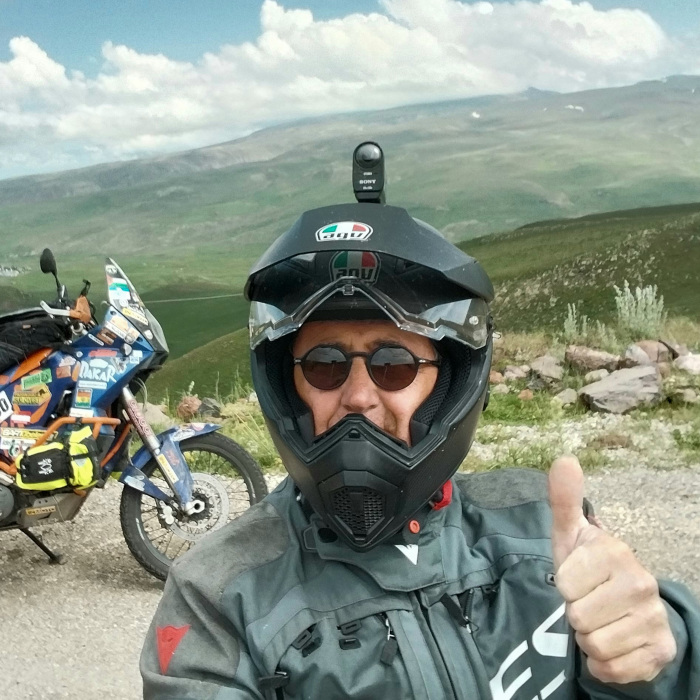
I was born in 1959 and I’ve been traveling around the world on a motorcycle for over 40 years. I’ve traveled more than 1,200,000 km and been on every continent. Lots of people think I’m courageous, but I always reply that I’m GP, a man with passion in him, who has built up some great experience. You can reach any place in the world, if you don’t run into politically unstable situations or bureaucracy, as happened to me this time. I still travel with maps. I don’t know what GPS is – I use the one in my brain, as a friend told me years ago. The great thing is to really lose yourself on the roads of the world.
The idea of this motorbike trip along the Silk Road came about, as always, because of my personal interest in the culture and history of the lands involved. I consider the Caucasus and Asia to be an ideal combination, where you can also create a relationship with the local peoples; time and the arrival of social media have changed the way people do things, but you can still breathe the air of the past.
The start was scheduled for June 1, 2023, but it was postponed by four days. With everything I consider necessary, including eight kilos of engine oil, I embark from Ancona for Durazzo, Albania, where I disembark the next day. I immediately head to the border with North Macedonia and in the evening I sleep by the lake in Mavrovo National Park. It’s cold but I'm well equipped.
The next day I arrive in Skopje, the capital, where the air of the east is already blowing. I visit the bazaar, with its colors and spices, then a tour of the historic center and it’s another story, a melting pot of ethnicities reflected in the many souvenir shops and restaurants, each with its own traditions and customs.
The next day I’d like to go up to Kosovo, to Prestina, but this is the period of clashes between the Kosovans and Serbians, so I decide to head towards Bulgaria when I arrive in Sofia, beneath a downpour. The modest house where I stay is also home to young Russians fleeing possible involvement in the war in Ukraine. I try to inflict conversation on them, but it doesn’t go further than a ‘hello’. I’ll have to get used to that.
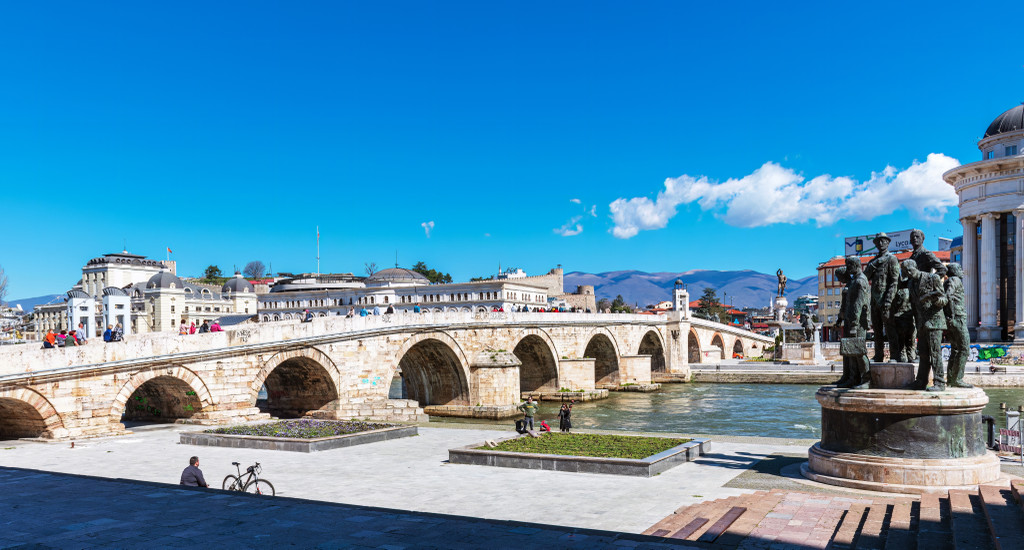
I visit the center by motorbike and then on to Plovdiv, where I sleep, but I also have time to visit the ancient Roman Theater of Philippopolis, which in the past could accommodate about 6,000 people; today it hosts operas and concerts. Then, in the city center, I pass next to the ancient stadium, dating back to the time of the emperor Hadrian.
I head south to the Turkish border. The temperatures have changed. I cross the border and turn my wheels in the direction of Gallipoli; I cross the bridge over the Dardanelles Strait, the longest in the world considering the three spans. As I approach Gallipoli I run into Paco and his wife standing on the side of the road, with their rear tire on the ground; I’d like to show off my personal workshop but they’ve already called for the tow truck. I stop in the city with them to fix the wheel and decide to stay in the same hotel.
I leave early in the morning, cross the bridge and find myself in Asia, geographically speaking. There are more than 2,000 km waiting for me in order to reach the Iraqi border at Zakho, Kurdistan. It’s all up and down through Turkey, if you want to avoid highways. I sleep in Cizre, before heading to the border. Here, everything has changed – temperatures, physiques, cultural habits. We’re in the militarized part of Turkish Kurdistan. For 150 km I skirted the border with Syria, 150 kilometers of barbed wire in 2 sectors.
Until 3 years ago, Iraqi Kurdistan was a place where ISIS had a presence, but now it’s an oasis of happiness, as Billy tells me. That’s what he calls himself – he’s lived in Italy and today works in customs. Because of him I can pass the checks in no time.
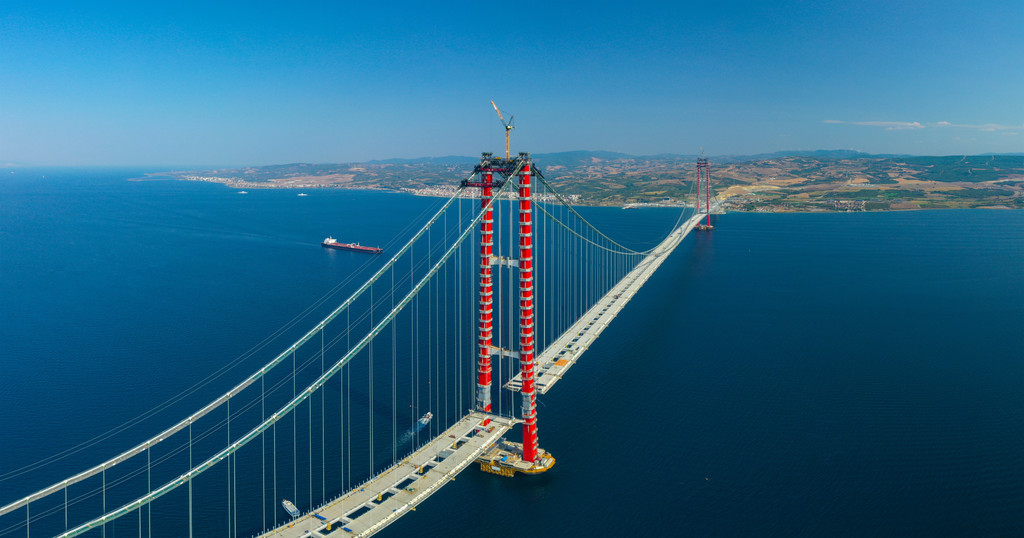
I ride down to Mosul, pass it and in the late afternoon arrive in Erbil. Having parked by bike, I adopt tourist configuration and head to the center, with the ancient citadel dominating the square below. It’s a swarm of people, there’s commerce under the arcades, it’s the bazaar; along the narrow streets you can find everything, immersed in the scenery of the past. The next day I go back to the center and stroll through the city, buy a kilo of cherries, and it doesn’t even cost me a euro. The reflection that springs spontaneously to mind is, again, about ISIS – there’s no trace of them here, so I propose to head north along the Iranian border the following day.
It’s hot, but after leaving Erbil I head up toward the mountains. I find the cool, but lots of military blockades as well. They politely ask me for my passport, but when they see I’m Italian, a ‘thanks’ and a ‘go’ are enough. I thank them and continue. In the evening I’m back at the border. My friend Billy is busy and I greet him by phone. At the Turkish border I wait more than an hour before the gates open. Everyone has worked hard to get me to park in the front row. I thank them and leave. In Cizre I stop at the same hotel as a few days ago and sink into bed.
I’ll take this opportunity for a brief digression on the clothing I chose for this motorcycle trip on the Silk Road. In order not to risk being unprepared, I’m wearing a 4-season suit, which allows me to feel good in a range from about 5 °C to over 30.
Above 35 degrees, well there’s not much you can do about that. It’s hard not to suffer from the heat. In any case, I also have an additional waterproof suit with me, in case of exceptional rainfall, which hasn’t been in short supply. The helmet I chose is an AGV AX9, an excellent full-face adventure helmet with peak and visor, comfortable and quiet. The boots are an adventure model as well, with a waterproof membrane. They’re also comfortable for short walks, as they’re soft enough, but they offer all the protection you need for riding on mixed terrain.
After breakfast, I head north, destination Lake Van. I pass more than 2,000 meters. The temperature has changed, but with my great technical outfit on it’s all relative.
I’m in the hard-bitten heart of Kurdistan, with centuries of traditions that have never settled down in the face of its unrecognized occupier, the Turkish government. There is no occasion, when I stop for a break, when I’m not reminded of this. I pass Tatavan and find a hotel by the lake in Ahlat. The owner is very kind – a new hotel with a restaurant nearby, a required stop for truckers, so it means you eat well.
It rains overnight but in the morning it’s clear. I visit the site just outside the city, a collection of Armenian and Arab art, then head north for Kars. After 300 km I arrive in the city. The Citadel with its fortification dominates the plain over which the rest of the city extends. History tells us of a location hotly contested from its origins, but especially by Turkey and Russia in the last century. For the whole of the Cold War, Kars was forgotten, then returned to the news in the 1990s when it had become the only entrance to Armenia. The Nogorno-Karabakh crisis, with the Azerbaijanis close to Turkey, led to the closure of the border, a situation that has now lasted for decades.
It’s raining as I heard up toward the Georgian border. In 2021, COVID meant I didn’t go the other way because the Turks weren’t letting people in, but this time I have no problems. The road down to Akhalkalaki is a long line of trucks. I go with the map and find myself in a small village where the road ends on private property – unbelievable. I retrace my steps and in an hour I cross the border with Armenia again, at record speed.
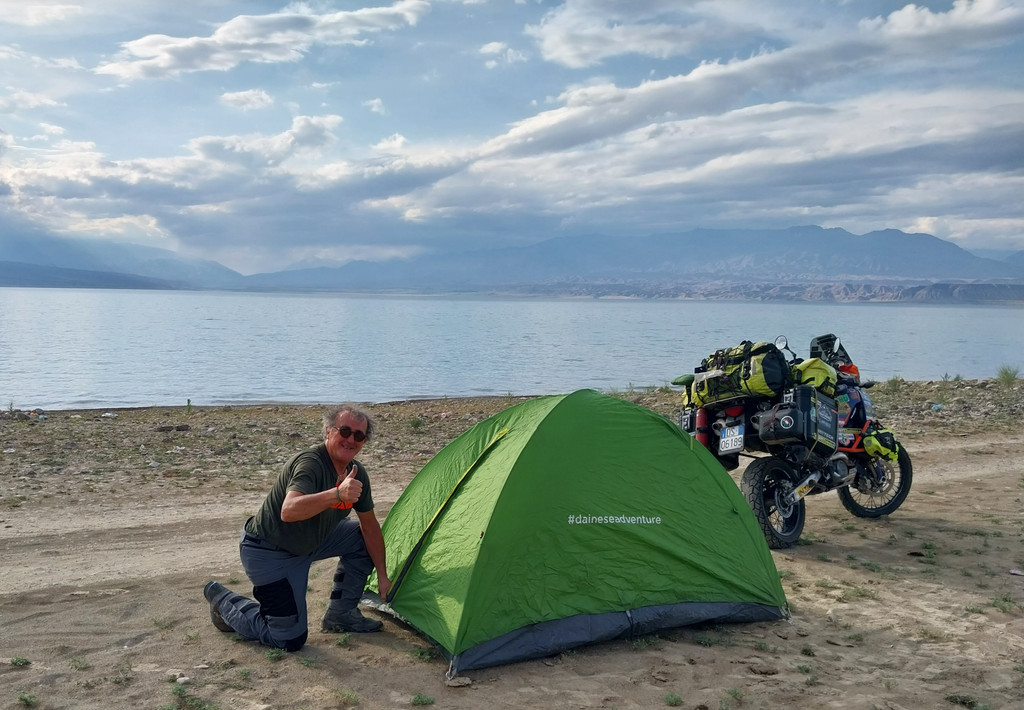
I head down to Gyumri still in the rain. It’s the most industrialized city in Armenia. The lady who welcomes me to the B&B is very kind. Too bad that she speaks French as a third language and neither Russian nor Armenian, so the telephone translator makes a big difference. Dinner then bedtime – I’m done. Here, too, I find young Russians who have fled their country to avoid war.
I return northward, headed for Lake Arpi National Park. the weather is having a fit. In the last 40 km the asphalt ends, but I don’t have problems with my KTM. I enter the park and fly the drone – amazing. I go back to the city by another road. Before the B&B it’s a mandatory stop for a wash, for which the bike is grateful.
It’s a hot day, after the storm. I turn east toward Varadzor. My friend Saro is waiting for me. Every time I set wheel in Armenia, it behooves me to drop by. Motorcycles in the garage and two days with the family – never go against custom. When it’s time to say goodbye I really can’t leave. Any excuse to stay will do.
But the next destination is Yerevan, the capital. There’s a mandatory stop in Spitak, where a mission supported by the Alpini association of Gorle, Bergamo, has the purpose of maintaining a facility housing about forty young people who wouldn’t have an easy life outside. Many of them have disabilities that mean they need to use wheelchairs. Too bad it’s rest time. The sister offers me a coffee. I leave a small offering, a drop of water in a stormy sea. Yerevan is chaotic and clashes with the lands I’ve experienced in recent days, having crossed lush plateaus. I’m on the outskirts, and I had to pass in front of my B&B 10 times before I found it. Luckily I found a lady who spoke English. Otherwise I’d still be there, going around in circles.
I spend a day planning my next steps. Armenia is an atypical country in terms of traditions – it was the first in the world to establish Christianity as the state religion, in a context that doesn’t favor it and where the eternal conflict of Nagorno-Karabakh is currently ongoing, at the time I write with a bitter epilogue.
The monasteries, in their infinity, are among the major attractions of this country. The most charismatic is located 50 km from Yerevan, the monastery of Korh Virap, close to the Turkish border and set against Mount Ararat, once in Armenian territory. Luckily there are no clouds, so its 5,700 meters and the snowy peak inspire endless shots.
I head south to the Tatev monastery, in bad weather once again. It’s perched on a mountain and getting to it feels like you’re on the roads in Stelvio. I stop here for two days and when I get back on the return route the weather has finally improved. I head towards Lake Sevan, one of the highest navigable lakes in the world. I stop at the monastery of Novarank, again perched on the mountain. Then, continuing to Sevan, I follow one of the ancient silk roads.
I sleep together with everyone else; everything is really pleasant and intimate. We talk as much as possible, but here if you don’t speak Russian, no dice. The next morning I go to visit the monastery of Savanank, located on a promontory, once an island until Stalin decided to create a channel to bring water elsewhere. The level today is 20 meters lower.
In the evening I arrive in Tbilisi and it’s a real letdown. My Georgian friend Giorgi tells me that the border with Azerbaijan is closed, an Azerbaijani decision that means the trip has to be reworked. I have two Russian visas that I should have used once I left Kazakhstan, but I had them scheduled for a date 20 days from now. I try to contact our embassy and they don’t even let me in. The way they treat me is baffling. I turn my back on them and go to an office where Russian visas are issued through the Swiss embassy.
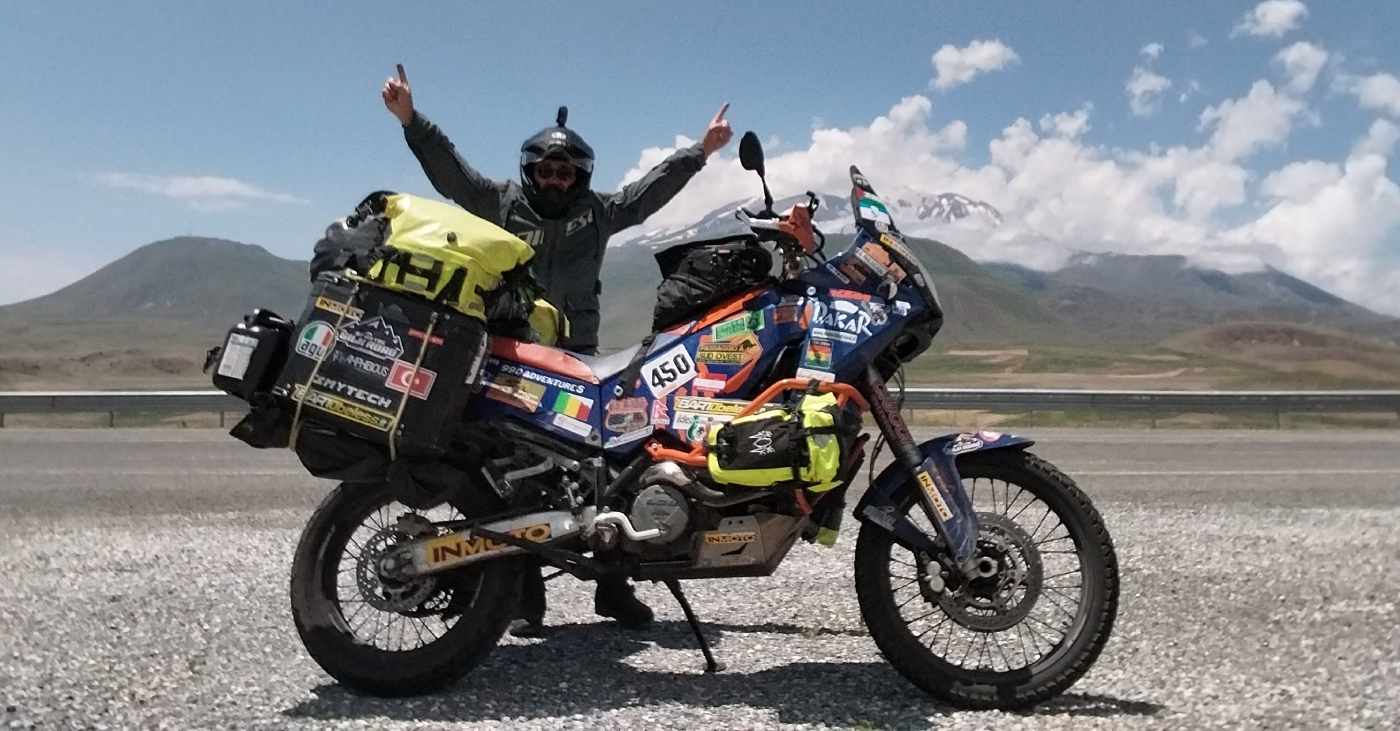
The Russian embassy closed its doors in 2008 when Russia invaded North Ossetia. Another letdown. They’ll issue me with a transit visa in six days, but I have to give up the visas I already had. I reflect and decide to do it even if I have to face the consequences. In the end, I lose more than 500 euros in translations, medical insurance and what I’d already spent. For the following days I’m a tourist, visiting some monasteries located towards the Caucasus and the old town of Vardzia, a little Georgian Cappadocia. Akahaltsikhe is the halfway point before returning to Tbilisi. A text message announces that the visa is ready, so motorcycle loaded and I head toward the northern border for Russia. I sleep in Stepantsaminda after visiting the Gergeti Trinity Church. The surrounding mountains are all covered with snow.
Next step, Russia. The journey continues, and you can keep on reading about it here: The Silk Road by Motorbike - from Georgia to Kyrgyzstan.